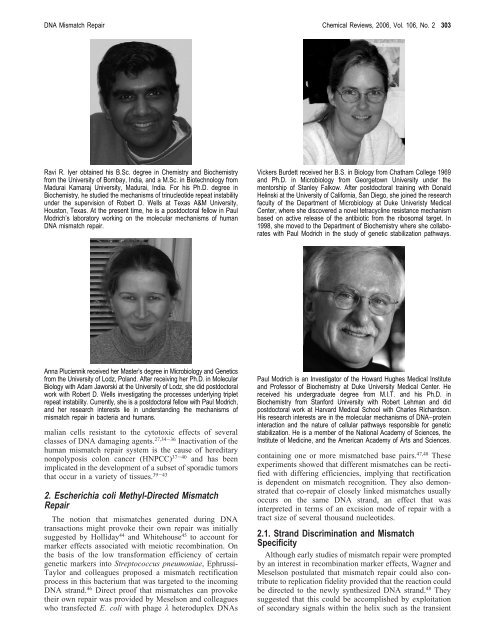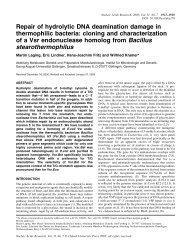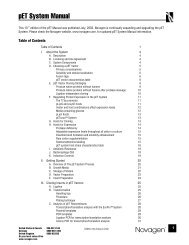DNA Mismatch Repair: Functions and Mechanisms
DNA Mismatch Repair: Functions and Mechanisms
DNA Mismatch Repair: Functions and Mechanisms
Create successful ePaper yourself
Turn your PDF publications into a flip-book with our unique Google optimized e-Paper software.
<strong>DNA</strong> <strong>Mismatch</strong> <strong>Repair</strong> Chemical Reviews, 2006, Vol. 106, No. 2 303<br />
Ravi R. Iyer obtained his B.Sc. degree in Chemistry <strong>and</strong> Biochemistry<br />
from the University of Bombay, India, <strong>and</strong> a M.Sc. in Biotechnology from<br />
Madurai Kamaraj University, Madurai, India. For his Ph.D. degree in<br />
Biochemistry, he studied the mechanisms of trinucleotide repeat instability<br />
under the supervision of Robert D. Wells at Texas A&M University,<br />
Houston, Texas. At the present time, he is a postdoctoral fellow in Paul<br />
Modrich’s laboratory working on the molecular mechanisms of human<br />
<strong>DNA</strong> mismatch repair.<br />
Vickers Burdett received her B.S. in Biology from Chatham College 1969<br />
<strong>and</strong> Ph.D. in Microbiology from Georgetown University under the<br />
mentorship of Stanley Falkow. After postdoctoral training with Donald<br />
Helinski at the University of California, San Diego, she joined the research<br />
faculty of the Department of Microbiology at Duke Univeristy Medical<br />
Center, where she discovered a novel tetracycline resistance mechanism<br />
based on active release of the antibiotic from the ribosomal target. In<br />
1998, she moved to the Department of Biochemistry where she collaborates<br />
with Paul Modrich in the study of genetic stabilization pathways.<br />
Anna Pluciennik received her Master’s degree in Microbiology <strong>and</strong> Genetics<br />
from the University of Lodz, Pol<strong>and</strong>. After receiving her Ph.D. in Molecular<br />
Biology with Adam Jaworski at the University of Lodz, she did postdoctoral<br />
work with Robert D. Wells investigating the processes underlying triplet<br />
repeat instability. Currently, she is a postdoctoral fellow with Paul Modrich,<br />
<strong>and</strong> her research interests lie in underst<strong>and</strong>ing the mechanisms of<br />
mismatch repair in bacteria <strong>and</strong> humans.<br />
malian cells resistant to the cytotoxic effects of several<br />
classes of <strong>DNA</strong> damaging agents. 27,34-36 Inactivation of the<br />
human mismatch repair system is the cause of hereditary<br />
nonpolyposis colon cancer (HNPCC) 37-40 <strong>and</strong> has been<br />
implicated in the development of a subset of sporadic tumors<br />
that occur in a variety of tissues. 39-43<br />
2. Escherichia coli Methyl-Directed <strong>Mismatch</strong><br />
<strong>Repair</strong><br />
The notion that mismatches generated during <strong>DNA</strong><br />
transactions might provoke their own repair was initially<br />
suggested by Holliday 44 <strong>and</strong> Whitehouse 45 to account for<br />
marker effects associated with meiotic recombination. On<br />
the basis of the low transformation efficiency of certain<br />
genetic markers into Streptococcus pneumoniae, Ephrussi-<br />
Taylor <strong>and</strong> colleagues proposed a mismatch rectification<br />
process in this bacterium that was targeted to the incoming<br />
<strong>DNA</strong> str<strong>and</strong>. 46 Direct proof that mismatches can provoke<br />
their own repair was provided by Meselson <strong>and</strong> colleagues<br />
who transfected E. coli with phage λ heteroduplex <strong>DNA</strong>s<br />
Paul Modrich is an Investigator of the Howard Hughes Medical Institute<br />
<strong>and</strong> Professor of Biochemistry at Duke University Medical Center. He<br />
received his undergraduate degree from M.I.T. <strong>and</strong> his Ph.D. in<br />
Biochemistry from Stanford University with Robert Lehman <strong>and</strong> did<br />
postdoctoral work at Harvard Medical School with Charles Richardson.<br />
His research interests are in the molecular mechanisms of <strong>DNA</strong>−protein<br />
interaction <strong>and</strong> the nature of cellular pathways responsible for genetic<br />
stabilization. He is a member of the National Academy of Sciences, the<br />
Institute of Medicine, <strong>and</strong> the American Academy of Arts <strong>and</strong> Sciences.<br />
containing one or more mismatched base pairs. 47,48 These<br />
experiments showed that different mismatches can be rectified<br />
with differing efficiencies, implying that rectification<br />
is dependent on mismatch recognition. They also demonstrated<br />
that co-repair of closely linked mismatches usually<br />
occurs on the same <strong>DNA</strong> str<strong>and</strong>, an effect that was<br />
interpreted in terms of an excision mode of repair with a<br />
tract size of several thous<strong>and</strong> nucleotides.<br />
2.1. Str<strong>and</strong> Discrimination <strong>and</strong> <strong>Mismatch</strong><br />
Specificity<br />
Although early studies of mismatch repair were prompted<br />
by an interest in recombination marker effects, Wagner <strong>and</strong><br />
Meselson postulated that mismatch repair could also contribute<br />
to replication fidelity provided that the reaction could<br />
be directed to the newly synthesized <strong>DNA</strong> str<strong>and</strong>. 48 They<br />
suggested that this could be accomplished by exploitation<br />
of secondary signals within the helix such as the transient




